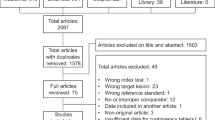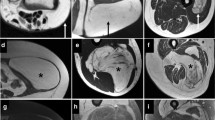Abstract
Background
Differentiating atypical lipomatous tumors (ALTs) and well-differentiated liposarcomas (WDLs) from benign lipomatous lesions is important for guiding clinical management, though conventional visual analysis of these lesions is challenging due to overlap of imaging features. Radiomics-based approaches may serve as a promising alternative and/or supplementary diagnostic approach to conventional imaging.
Purpose
The purpose of this study is to review the practice of radiomics-based imaging and systematically evaluate the literature available for studies evaluating radiomics applied to differentiating ALTs/WDLs from benign lipomas.
Review
A background review of the radiomic workflow is provided, outlining the steps of image acquisition, segmentation, feature extraction, and model development. Subsequently, a systematic review of MEDLINE, EMBASE, Scopus, the Cochrane Library, and the grey literature was performed from inception to June 2022 to identify size studies using radiomics for differentiating ALTs/WDLs from benign lipomas. Radiomic models were shown to outperform conventional analysis in all but one model with a sensitivity ranging from 68 to 100% and a specificity ranging from 84 to 100%. However, current approaches rely on user input and no studies used a fully automated method for segmentation, contributing to interobserver variability and decreasing time efficiency.
Conclusion
Radiomic models may show improved performance for differentiating ALTs/WDLs from benign lipomas compared to conventional analysis. However, considerable variability between radiomic approaches exists and future studies evaluating a standardized radiomic model with a multi-institutional study design and preferably fully automated segmentation software are needed before clinical application can be more broadly considered.
Similar content being viewed by others
References
WHO Classification of Tumours Editorial Board. WHO Classification of tumours: soft tissue and bone tumours. International Agency for Research on Cancer. 2020.
Johnson CN, Ha AS, Chen E, Davidson D. Lipomatous soft-tissue tumors: J Am Acad Orthop Surg. 2018;26:779–88.
Weaver J, Downs-Kelly E, Goldblum JR, Turner S, Kulkarni S, Tubbs RR et al. Fluorescence in situ hybridization for MDM2 gene amplification as a diagnostic tool in lipomatous neoplasms. Mod Pathol Off J U S Can Acad Pathol Inc. 2008;21:943–9.
Nagano S, Yokouchi M, Setoguchi T, Ishidou Y, Sasaki H, Shimada H, et al. Differentiation of lipoma and atypical lipomatous tumor by a scoring system: implication of increased vascularity on pathogenesis of liposarcoma. BMC Musculoskelet Disord. 2015;16:36.
Asano Y, Miwa S, Yamamoto N, Hayashi K, Takeuchi A, Igarashi K, et al. A scoring system combining clinical, radiological, and histopathological examinations for differential diagnosis between lipoma and atypical lipomatous tumor/well-differentiated liposarcoma. Sci Rep Nature Publishing Group. 2022;12:237.
Brisson M, Kashima T, Delaney D, Tirabosco R, Clarke A, Cro S, et al. MRI characteristics of lipoma and atypical lipomatous tumor/well-differentiated liposarcoma: retrospective comparison with histology and MDM2 gene amplification. Skeletal Radiol. 2013;42:635–47.
O’Donnell PW, Griffin AM, Eward WC, Sternheim A, White LM, Wunder JS, et al. Can experienced observers differentiate between lipoma and well-differentiated liposarcoma using only MRI? Sarcoma. 2013;2013:982784.
Malinauskaite I, Hofmeister J, Burgermeister S, Neroladaki A, Hamard M, Montet X, et al. Radiomics and machine learning differentiate soft-tissue lipoma and liposarcoma better than musculoskeletal radiologists. Sarcoma. 2020;2020:1–9.
Tomaszewski MR, Gillies RJ. The biological meaning of radiomic features. Radiology. 2021;298:505–16.
Gillies RJ, Kinahan PE, Hricak H. Radiomics: images are more than pictures, they are data. Radiology. 2016;278:563–77.
Larue RTHM, Defraene G, De Ruysscher D, Lambin P, van Elmpt W. Quantitative radiomics studies for tissue characterization: a review of technology and methodological procedures. Br J Radiol. 2017;90:20160665.
Kinahan PE, Perlman ES, Sunderland JJ, Subramaniam R, Wollenweber SD, Turkington TG, et al. The QIBA profile for FDG PET/CT as an imaging biomarker measuring response to cancer therapy. Radiology. 2020;294:647–57.
Predictive modeling, machine learning, and statistical issues [Internet]. Radiomics Radiogenomics. Chapman and Hall/CRC; 2019 [cited 2022 Jul 3]. p. 151–68. Available from: https://www.taylorfrancis.com/chapters/edit/10.1201/9781351208277-9/predictive-modeling-machine-learning-statistical-issues-panagiotis-korfiatis-timothy-kline-zeynettin-akkus-kenneth-philbrick-bradley-erickson
Shur JD, Doran SJ, Kumar S, ap Dafydd D, Downey K, O’Connor JPB, et al. Radiomics in oncology: A practical guide. RadioGraphics. 2021;41:1717–32 (Radiological Society of North America)
Parmar C, Velazquez ER, Leijenaar R, Jermoumi M, Carvalho S, Mak RH, et al. Robust radiomics feature quantification using semiautomatic volumetric segmentation. PLOS One. 2014;9:e102107.
Bera K, Braman N, Gupta A, Velcheti V, Madabhushi A. Predicting cancer outcomes with radiomics and artificial intelligence in radiology. Nat Rev Clin Oncol. 2022;19:132–46.
Hosny A, Aerts HJ, Mak RH. Handcrafted versus deep learning radiomics for prediction of cancer therapy response. Lancet Digit Health Elsevier. 2019;1:e106–7.
Gebejes A, Huertas R. Texture characterization based on grey-level co-occurrence matrix. Proc Conf Inform Manag Sci. 2013;3:375–378.
van Timmeren JE, Cester D, Tanadini-Lang S, Alkadhi H, Baessler B. Radiomics in medical imaging—“how-to” guide and critical reflection. Insights Imaging. 2020;11:91.
Park JE, Park SY, Kim HJ, Kim HS. Reproducibility and generalizability in radiomics modeling: possible strategies in radiologic and statistical perspectives. Korean J Radiol. 2019;20:1124–37.
Zwanenburg A, Leger S, Agolli L, Pilz K, Troost EGC, Richter C, et al. Assessing robustness of radiomic features by image perturbation. Sci Rep. 2019;9:614.
Leporq B, Bouhamama A, Pilleul F, Lame F, Bihane C, Sdika M, et al. MRI-based radiomics to predict lipomatous soft tissue tumors malignancy: a pilot study. Cancer Imaging. 2020;20:78.
Cay N, Mendi BAR, Batur H, Erdogan F. Discrimination of lipoma from atypical lipomatous tumor/well-differentiated liposarcoma using magnetic resonance imaging radiomics combined with machine learning. Jpn J Radiol [Internet]. 2022 [cited 2022 Jun 7]; Available from: https://link.springer.com/10.1007/s11604-022-01278-x
Thornhill RE, Golfam M, Sheikh A, Cron GO, White EA, Werier J, et al. Differentiation of lipoma from liposarcoma on MRI using texture and shape analysis. Acad Radiol. 2014;21:1185–94.
Vos M, Starmans MPA, Timbergen MJM, van der Voort SR, Padmos GA, Kessels W, et al. Radiomics approach to distinguish between well differentiated liposarcomas and lipomas on MRI. Br J Surg. 2019;106:1800–9.
Tang Y, Cui J, Zhu J, Fan G. Differentiation between lipomas and atypical lipomatous tumors of the extremities using radiomics. J Magn Reson Imaging. 2022;56:1746–1754.
Pressney I, Khoo M, Endozo R, Ganeshan B, O’Donnell P. Pilot study to differentiate lipoma from atypical lipomatous tumour/well-differentiated liposarcoma using MR radiomics-based texture analysis. Skeletal Radiol. 2020;49:1719–29.
Kalpathy-Cramer J, Mamomov A, Zhao B, Lu L, Cherezov D, Napel S, et al. Radiomics of lung nodules: a multi-institutional study of robustness and agreement of quantitative imaging features. Tomography. 2016;2:430–7.
Bleker J, Kwee TC, Rouw D, Roest C, Borstlap J, de Jong IJ, et al. A deep learning masked segmentation alternative to manual segmentation in biparametric MRI prostate cancer radiomics. Eur Radiol. 2022;32:6526–35.
Chen MY, Woodruff MA, Dasgupta P, Rukin NJ. Variability in accuracy of prostate cancer segmentation among radiologists, urologists, and scientists. Cancer Med. 2020;9:7172–82.
Gitto S, Cuocolo R, Albano D, Morelli F, Pescatori LC, Messina C, et al. CT and MRI radiomics of bone and soft-tissue sarcomas: a systematic review of reproducibility and validation strategies. Insights Imaging. 2021;12:68.
Wang B, Lei Y, Tian S, Wang T, Liu Y, Patel P, et al. Deeply supervised 3D fully convolutional networks with group dilated convolution for automatic MRI prostate segmentation. Med Phys. 2019;46:1707–18.
Ushinsky A, Bardis M, Glavis-Bloom J, Uchio E, Chantaduly C, Nguyentat M, et al. A 3D–2D hybrid U-Net convolutional neural network approach to prostate organ segmentation of multiparametric MRI. AJR Am J Roentgenol. 2021;216:111–6.
Fradet G, Ayde R, Bottois H, El Harchaoui M, Khaled W, Drapé J-L, et al. Prediction of lipomatous soft tissue malignancy on MRI: comparison between machine learning applied to radiomics and deep learning. Eur Radiol Exp. 2022;6:41.
Author information
Authors and Affiliations
Corresponding author
Ethics declarations
Conflict of interest
The authors declare that they have no conflict of interest.
Additional information
Publisher's note
Springer Nature remains neutral with regard to jurisdictional claims in published maps and institutional affiliations.
Rights and permissions
Springer Nature or its licensor (e.g. a society or other partner) holds exclusive rights to this article under a publishing agreement with the author(s) or other rightsholder(s); author self-archiving of the accepted manuscript version of this article is solely governed by the terms of such publishing agreement and applicable law.
About this article
Cite this article
Haidey, J., Low, G. & Wilson, M.P. Radiomics-based approaches outperform visual analysis for differentiating lipoma from atypical lipomatous tumors: a review. Skeletal Radiol 52, 1089–1100 (2023). https://doi.org/10.1007/s00256-022-04232-0
Received:
Revised:
Accepted:
Published:
Issue Date:
DOI: https://doi.org/10.1007/s00256-022-04232-0




